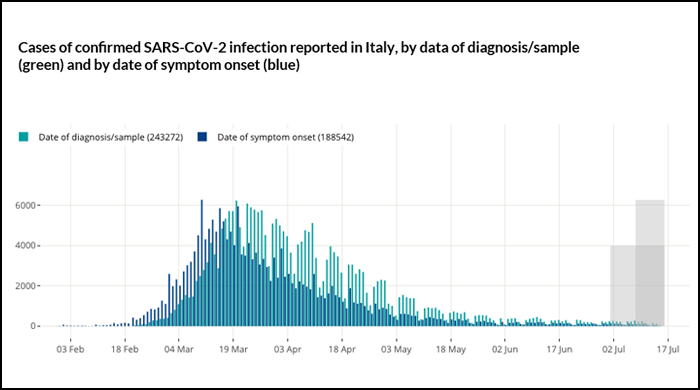Key Points
The overall picture of the transmission and impact of the SARS-CoV-2 infection in Italy remains one of a low level of criticality with a cumulative incidence of the previous 14 days (June 29-July 12) of 4.6 per 100,000 inhabitants (up slightly).
At the national level, a slight increase in the number of newly diagnosed cases reported to the integrated surveillance system coordinated by the ISS was observed in the week of July 6-13 with respect to the previous week of monitoring, with a national Rt reproduction number of 1.01, although it is below 1 in the interval of lower confidence. This indicates that transmission in our country has been substantially stable in recent weeks.
These are the findings of the health ministry, the Cabina di Regia and the Higher Health Institute’s weekly monitoring report on phase two of the coronavirus emergency, regarding the period following the third phase of activity reopenings on June 3.
It is likely that for many of the cases reported during that week, the infection was contracted two-three weeks earlier, so prevalently in the last 10 days of June.
Some of the cases identified via screening, however, may have contracted the infection previously. New cases of infection were diagnosed in almost all of the regions and autonomous provinces during the week of monitoring, with an increase in cases with respect to the previous week of monitoring in some. This is largely due to intense screening and investigation of cases, with the identification and monitoring of close contacts.
In addition to outbreaks attributable to the importation of infection, some small chains of transmission of unknown origin continue to be reported on the national territory.
This highlights the fact that the COVID-19 epidemic in Italy is not over.
In some regions, the presence of new cases of infection imported from other regions or foreign states was highlighted.
The epidemiological situation, therefore, remains extremely fluid. The Rt estimates continue to fluctuate in some regions and autonomous provinces in relation to outbreaks of transmission hotspots that are subsequently contained.
As a result, in the last 14 days, estimates of Rt rates of over 1 have been observed in six regions where there have been recent outbreaks. There continue to be no signs of care services being overwhelmed. Although in decline, the number of new cases reported remains high in some regions.
This calls for caution as it shows that, in some parts of the country, SARS-CoV-2 is still circulating in a significant way. It is essential to keep attention levels high and continue to strengthen testing-tracing-tracking activities in order to be able to quickly identify all the potential transmission hotspots and keep control of the epidemic.
Otherwise, we could see a reversal of the trend in the coming weeks, with a significant increase in the number of cases at the national level.
For this reason it is necessary to keep awareness high about the fluidity of the epidemiological situation and the importance of continuing to rigorously respect of the measures necessary to reduce the risk of transmission, such as individual hygiene and physical distancing.
Conclusions
Although Italy’s lockdown measures made it effectively possible to control SARS-CoV-2 infection, at the moment we are in a situation of stationary transmission at the national level in which widespread transmission of the virus persists and which, when favourable conditions occur, causes outbreaks, including some of a significant size and are sometimes linked to cases of infection contracted in foreign states.
The number of new cases of infection remains contained on the whole. This is thanks to testing-tracing-tracking activities, which make it possible to break potential transmission chains at an early stage. The reduction in the time between the start of symptoms and diagnosis/isolation makes faster identification and clinical care for the people who contract the infection possible.
It is not surprising to observe a low number of cases that require hospitalization as, given the characteristics of the COVID-19 illness, only a small proportion of the total number of people who contract the SARS-CoV-2 virus go on to have a serious clinical situation.
This outcome, which was expected on the basis of the strategy adopted during the transition phase, makes it possible to manage the presence of the virus on the national territory, in a situation of reopened activities, without overloading health care services.
Source: Ansa
Fonte Salute.gov.it News
